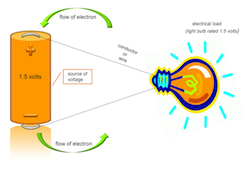Learn about Conductors and Insulators
The flow of electricity through conductors is similar to water flowing through pipes and fittings. When electrons flow freely through a material, we say that there is “little resistance” and the material is called a conductor. Copper and aluminum are typical conductors used in electrical wires of varying diameter. In the same way that a fire hose carries more water than a garden hose, a larger-diameter electrical wire allows more electrons to flow than a smaller one. A bigger diameter thus allows more current (higher amperage).
Prior to using electricity, a complete circuit must be set up. This is done by linking the voltage source to a chosen conductor (usually electric cable) which allows electrons to flow freely from the source to the destination load (an appliance or other electric equipment) and back to the source. The circuit is thus complete.
The illustration shows the operation of a simple flashlight. Stored electrons in the battery are forced to flow into the conductor from the negative terminal (-) by the voltage (pressure). They pass through the light bulb (load) before completing the circuit by heading back to the positive terminal (+). This is known as direct current (or DC). The light bulb remains lit until there are no more electrons (the battery runs flat) or the flashlight is switched off, breaking the circuit so that the electrons have nowhere to flow to.
A switch is a standard means of turning the flashlight on or off and preserving the electrons stored in the battery (when it’s off) by breaking the flow of electrons through the conductors. But how does a switch break a circuit and stop electron flow? It’s very easy: a non-conducting substance is inserted into the circuit and wired in series. This kind of substance is called an insulator. When the switch is moved to the ‘off’ position, the insulator is inserted into the circuit and stops electron flow; in the ‘on’ position, the insulator is removed and the circuit is once again complete, allowing electrons to flow to (and through) the load and lighting the bulb. Rubber, air, plastics, glass, and ceramics are common insulators.
